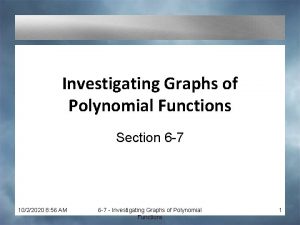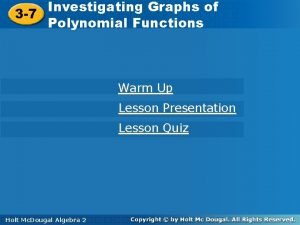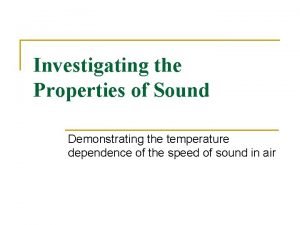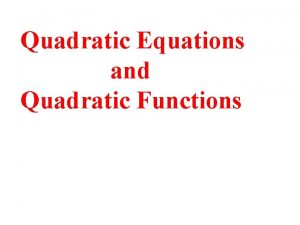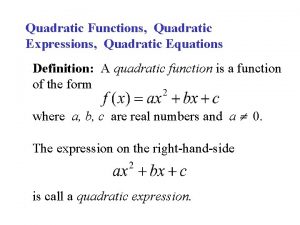Chapter 3 Quadratic Functions 3 1 Investigating Quadratic






- Slides: 6

Chapter 3 Quadratic Functions

3. 1 Investigating Quadratic Functions in Vertex Form A quadratic function is a function (f) whose value f(x) at x is given by a polynomial of a degree 2. ( ex. f(x) = x 2 ) The graph of a quadratic function is called the parabola (a symmetrical curve). When the graph opens upwards, the vertex is the lowest point of the graph and has a minimum value. When the graph opens downwards, the vertex is the highest point on the graph, and has a maximum value. The parabola also has an axis of symmetry, which is a line through the vertex that divides the graph into two congruent halves. Also the x-coordinate of the vertex corresponds to the equation of the axis of symmetry. Quadratic functions are written in vertex form that tells you the location of the vertex: (p, q), the shape of the parabola and the direction of opening. The formula is: - f(x) = a(x - p)2 + q a determines the orientation and shape of the parabola the graph opens upwards if a > 0 and downward if a < 0 if -1 < a < 1, the parabola is wider compared to the graph of f(x) = x 2 if a > 1 or a < -1, the parabola is narrower compared to the graph of f(x) = x 2

Example: Determine the following characteristics for the function: the vertex, the domain and range, the direction of opening, and the axis of symmetry. y = 2(x + 1)2 - 3 Since p = -1 and q = -3, the vertex is then located at (-1, -3). Since a > 0, the graph opens upwards. Also, a > 1, the parabola is narrow. Since q = -3, the range is { y | y ≥ -3, y ∈ R } The domain is { x | x ∈ R }. Since p = -1, the axis of symmetry is x = -1.

3. 2 Investigating Quadratic Functions in Standard Form The standard form of a quadratic function is f(x) = ax 2 + bx + c or y = ax 2 + bx + c , where a, b, and c are real numbers and a ≠ 0. - a determines the shape and the direction of opening b influences the horizontal position of the graph c determines the y-intercept of the graph In this section, a way to find the vertex form when given the standard form is: b = -2 ap or p = -b 2 a and c = ap 2 + q or q = c - ap 2 Recall that to determine the x-coordinate of the vertex, you can use the equation x = p. So the coordinate of the vertex is x = -b 2 a

3. 3 Completing the Square Another way of finding the vertex form when given the standard form is by completing the square. Completing the square is an algebraic process used to write a quadratic polynomial in the form a(x - p)2 + q. Method of Completing the Square: - factor a (the coefficient of x 2) out of the right side of the equation. - add and subtract the square of half the coefficient of the x-term to both sides of the equation - group the square trinomial (factor the right side of the equation -there will always be two identical factors-) - solve the equation for y, so that the equation is in vertex form

Example 1: Complete the square of y = x 2 - 8 x + 5 y = (x 2 - 8 x) +5 2 y = (x - 8 x + 16) + 5 - 16 y = (x- 4)2 - 11 Group the first two terms Add & subtract the square of half the coefficient of the x term Rewrite as the square of a binomial Simplify Example 2: Complete the square of y = 3 x 2 -12 x -9 y = 3(x 2 - 4 x) -9 y = 3(x 2 - 4 x ) -9 2 y = 3(x - 4 x + 4) -9 - 12 y = 3(x 2 - 4 x + 4) -21 y = 3(x - 2)2 -21 Only factor out the first two terms Multiply 4 by 3 Rewrite as the square of the binomial


